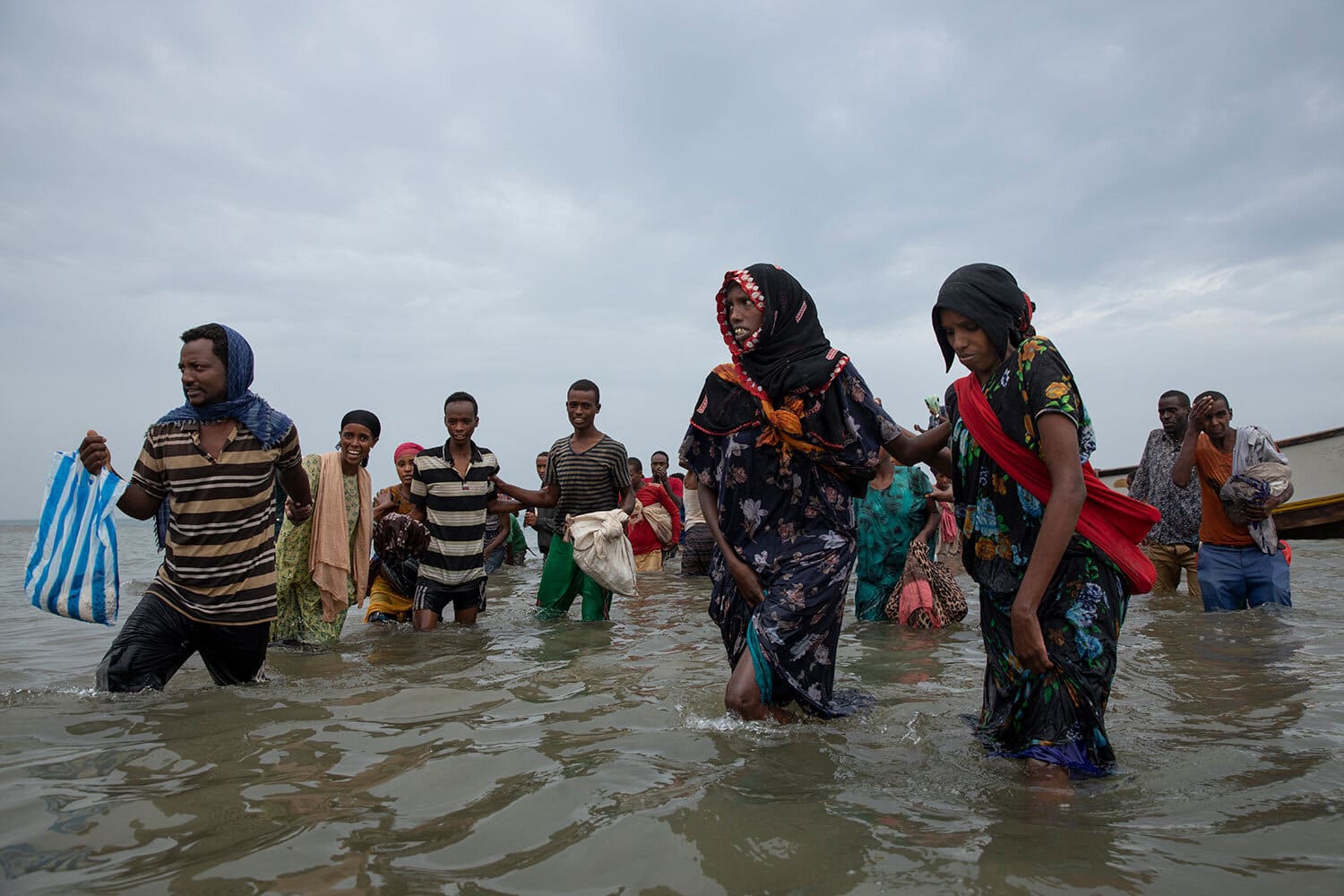
(Photo: Associated Press)
Last updated on: 24-08-2025 at 12 PM Aden Time

|
|
"Shabwa Governorate finds itself caught at the epicenter of a transboundary crisis, where humanitarian imperatives intersect with security, social, and service-related pressures. Local authorities say they are operating on their own, without institutional or international support".
Abdullah Al-Shadli (South24)
In recent years, illegal migration through southern Yemen has intensified, drawing attention to the coastal governorate of Shabwa, which has rapidly emerged as a critical transit point along the ’Eastern Route‘ for migrants crossing over from the Horn of Africa to the Gulf. This corridor spans vast stretches of open shoreline and is classified by the International Organization for Migration (IOM) as one of the world’s most perilous migration routes, due to the elevated risk of drowning, starvation, and thirst at sea.
The region has witnessed a series of harrowing tragedies, including the sinking of an overcrowded vessel off the coast of Abyan that claimed dozens of lives, followed by the arrival of another boat on Shabwa’s shores carrying migrants, some of who had perished after days adrift.
These recurring disasters underscore the gravity of the situation confronting both governorates, with Shabwa in particular positioned at the epicenter of the crisis, confronting it with limited local resources and the lack of any dedicated international or regional support.
Local officials and experts believe that Shabwa's unique geographical location, close to the Horn of Africa and overlooking a 220-300 km stretch of coastline, most of which is uninhabited, has rendered it a preferred destination for smuggling networks amid weak maritime oversight. Against this backdrop, humanitarian consequences converge with mounting security, social, and service-related risks, threatening to transform southern Yemen into a permanent hub for human trafficking unless urgent action is taken.
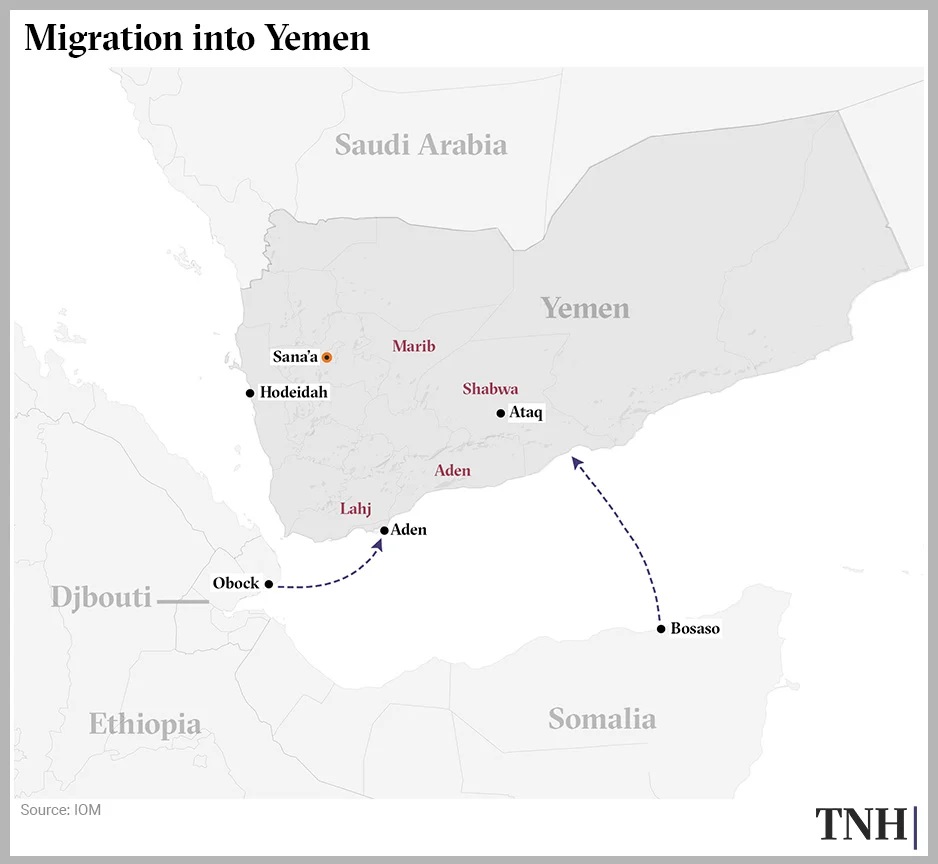
A map showing the illegal migration routes to Yemen from the Horn of Africa—specifically from Djibouti and Somalia—highlighting key cities and ports along both sides of the corridor. (New Humanity – International Organization for Migration)
Recent Incidents Along the Migration Corridor
On August 3, the neighboring governorate of Abyan was shaken by a new humanitarian tragedy when an overcrowded boat carrying illegal migrants capsized off its coast. Initial reports cited dozens of casualties, but the death toll continued to rise as search operations progressed. According to security sources cited by Reuters, the number of fatalities reached 86, later updated by Abyan’s Health Office Director to 92, with many still unaccounted for.
This tragedy unfolded amid a sweeping military and security campaign led by Abyan’s police targeting smuggler camps and hideouts in coastal areas, particularly in the districts of Shaqra and Ahwar, in an effort to disrupt smuggling operations.
While attention was focused on the Abyan incident, Shabwa witnessed a separate tragedy on August 5, when the IOM reported the arrival of a vessel carrying 250 Ethiopian migrants to the shores of Arqah in Rudum District. That journey too was marked by calamity: Seven passengers died of hunger and thirst after the boat’s engine failed at sea. Survivors recounted spending a full week adrift, relying on wind and rudimentary paddling to reach land.
In a previous tragic incident in June 2024, at least 49 African migrants died and around 140 went missing after a boat carrying 260 migrants capsized off Shabwa’s coast. According to Shabwa’s Health Office, 45 bodies were recovered, including of 27 women, while four individuals were rescued in critical condition. The internationally recognized government’s Coast Guard, along with IOM teams, participated in the search and rescue operations.
Shabwa’s Emergence as a Strategic Transit Hub
Field data confirms that Shabwa is no longer an occasional arrival point for illegal migrants but has become a central gateway for transit to other Yemeni governorates and the Gulf countries, particularly Saudi Arabia.
In a statement to ‘South24’, Brigadier General Fouad Al-Nassi, Director of Shabwa’s Security Department, noted that the governorate’s coastline spans approximately 300 kilometers, facilitating direct access from the Horn of Africa. He added, “Limited operational capacity has hindered our ability to monitor the coastline, enabling illegal entry.”
Dr. Sheikh Banafe’, Director of the Governor’s Office in Shabwa, told ‘South24’ that several factors make the governorate a preferred destination for smuggling networks, chiefly “its geographic proximity to the Horn of Africa and its open, largely uninhabited coastline, which allows smuggling boats to reach its shores without being monitored”.
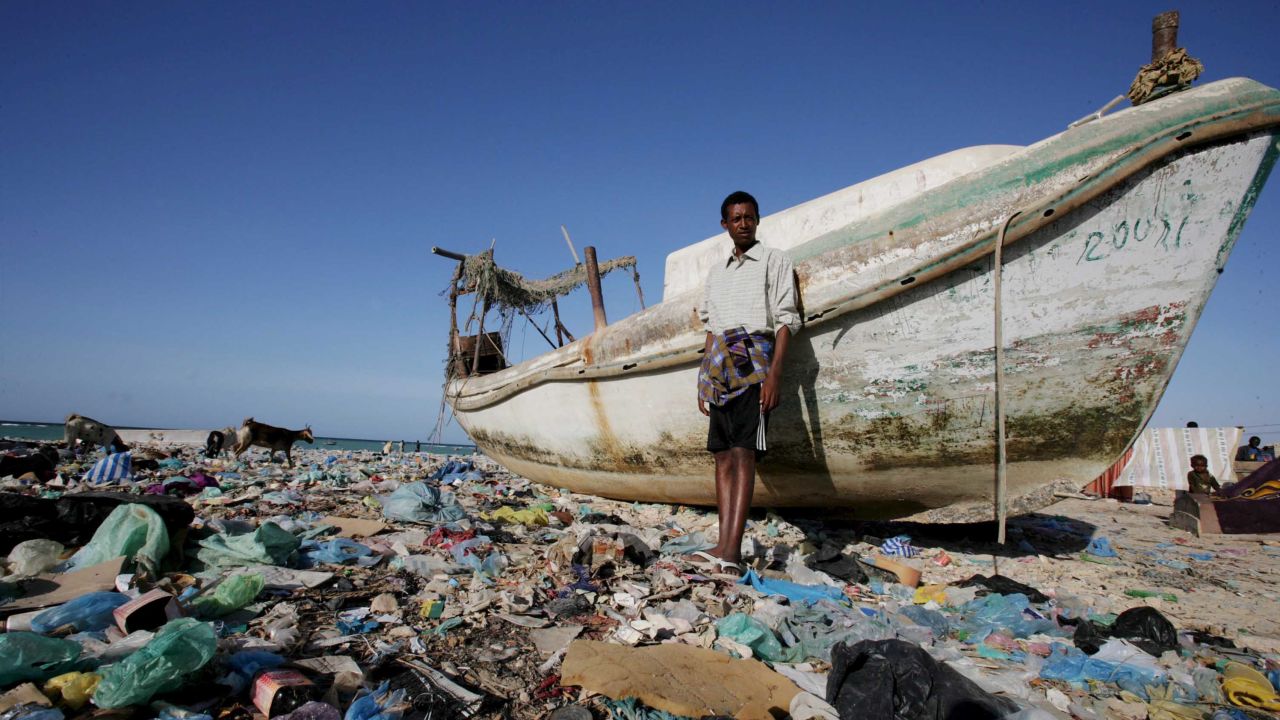
A 2007 photo of an Ethiopian migrant who had undertaken multiple illegal crossings to Yemen. (CNN)
Journalist Farid Baras concurred, stating that Shabwa “serves as a gateway for transit to other governorates and the Gulf countries, especially Saudi Arabia.” He noted that weak monitoring at certain border and coastal entry points renders the region vulnerable to human flows.
Official data obtained by ‘South24’ illustrates the scale of the phenomenon: Between January and the end of July 2025, approximately 8,208 African migrants arrived in Shabwa, including 6,719 Ethiopians and 1,489 Somalis.
These figures place the governorate at the epicenter of the “Eastern Route”, which the IOM describes as one of the world’s most dangerous migration corridors, having witnessed the death or disappearance of over 350 migrants since the beginning of the year. In a recent statement, IOM Chief of Mission in Yemen Abdul Sattar Isayev warned that “tragedies will continue as migrants take increasingly dangerous sea routes”.
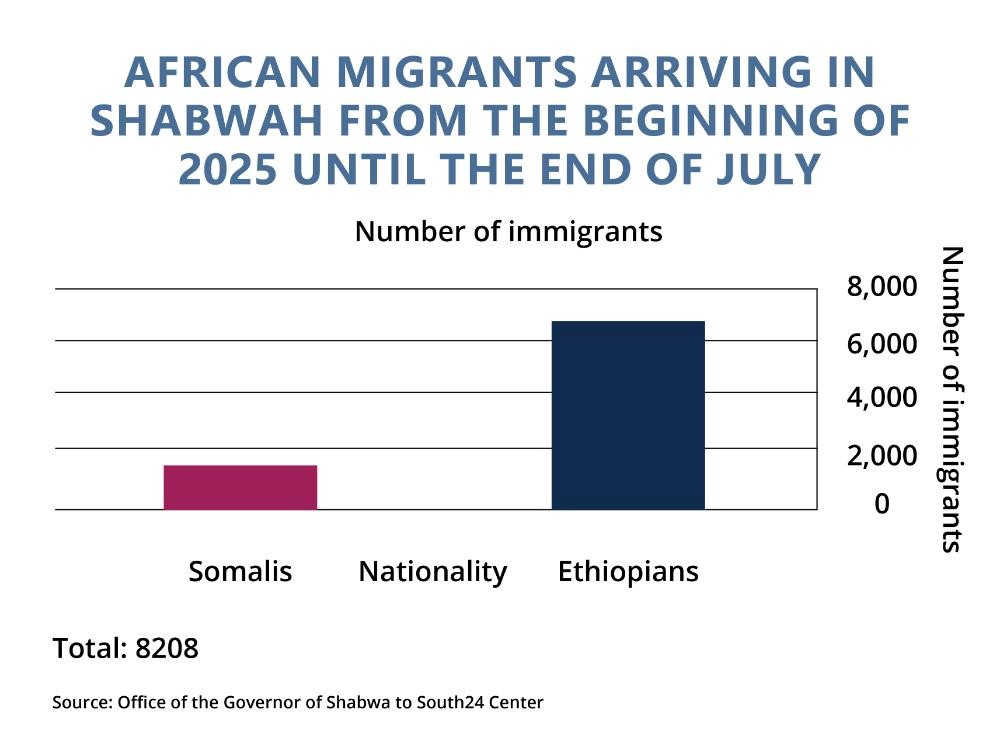
Humanitarian Suffering
Although the dangers faced by the African migrants begin as soon as they start their journey across the Arabian Sea, their suffering does not end upon reaching Shabwa. In September 2024, the governorate witnessed a notable incident when security forces conducted a joint operation that freed 30 Ethiopian migrants from the clutches of a gang of the same nationality, who had detained them in a house near Al-Saeed junction in Ataq city.
According to a statement from Shabwa’s Media Office, the gang—comprising four illegal migrants—had targeted fellow Ethiopian nationals, demanding ransoms of up to 3,000 Saudi riyals (approximately $800) per person, while subjecting the victims to torture during captivity.
This incident was not isolated from a broader context. A short documentary released by ‘South24’ weeks earlier highlighted the suffering of African migrants in Shabwa, exposing human trafficking operations carried out by African migrants and local men, particularly targeting Ethiopian women and girls. Although the center could not independently verify all testimonies, it called on security authorities to investigate and confront these practices.
These events reveal that Shabwa, in addition to being a key transit point on the illegal migration route to Saudi Arabia and the Gulf, has also become a theater for criminal exploitation networks that exacerbate the humanitarian risks faced by migrants, amid the lack of effective protection from local authorities and international organizations.
Challenges and the Lack of Support
Despite the severity of the crisis and the scale of human flows into Shabwa, local officials affirm that the governorate receives no dedicated international or regional support to address this phenomenon, and relies solely on its limited resources.
Brigadier General Fouad Al-Nassi stated that security agencies receive no support to combat illegal migration, emphasizing that addressing the issue requires “equipping the governorate with advanced border surveillance technologies, enhancing Coast Guard capabilities to monitor and secure the coastline, and conducting sustained community awareness campaigns on the dangers of illegal migration.”
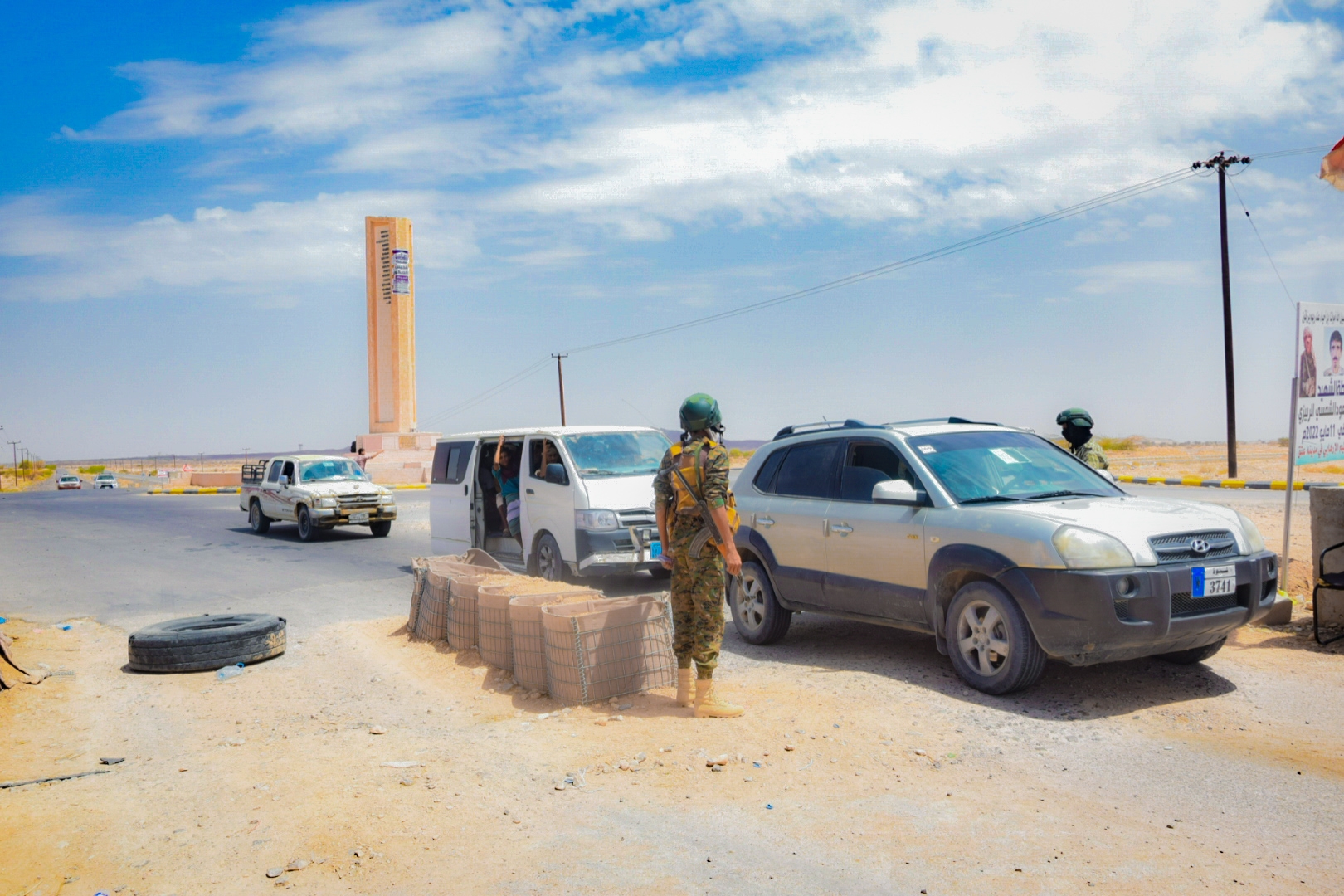
A military checkpoint operated by the Shabwa Defense Forces, (February 1, 2023. South24 Center)
Dr. Sheikh Banafe’ added that the local authority “currently lacks any dedicated international or regional support programs for this file and relies solely on its limited capabilities”. He stressed that “the scale of human influx far exceeds the available capacities”.
Banafe’ pointed out that one of the main challenges is “the absence of Coast Guard operations due to the destruction of coastal security infrastructure, which has left the shoreline completely exposed”. He also cited “financial and logistical constraints and at times weak institutional coordination among the relevant entities”.
Journalist Farid Baras commented, “To date, I don’t believe Shabwa receives sufficient support to enable it to effectively confront illegal migration”.
Social expert Nasser Lashram told ‘South24’ that the solution is not limited to security measures, but rather requires “greater financial and technical support from the central government and the international community, along with programs to create sustainable employment opportunities for citizens”.
Impact on Security and Society
The illegal migration crisis in Shabwa extends beyond the humanitarian tragedies at sea, casting a heavy shadow over the local community, and generating cumulative security, social, and service-related consequences.
Dr. Sheikh Banafe’ noted that the influx of migrants has been linked to rising rates of theft, altercations, and violent crimes, particularly in neighborhoods with high migrant concentrations.
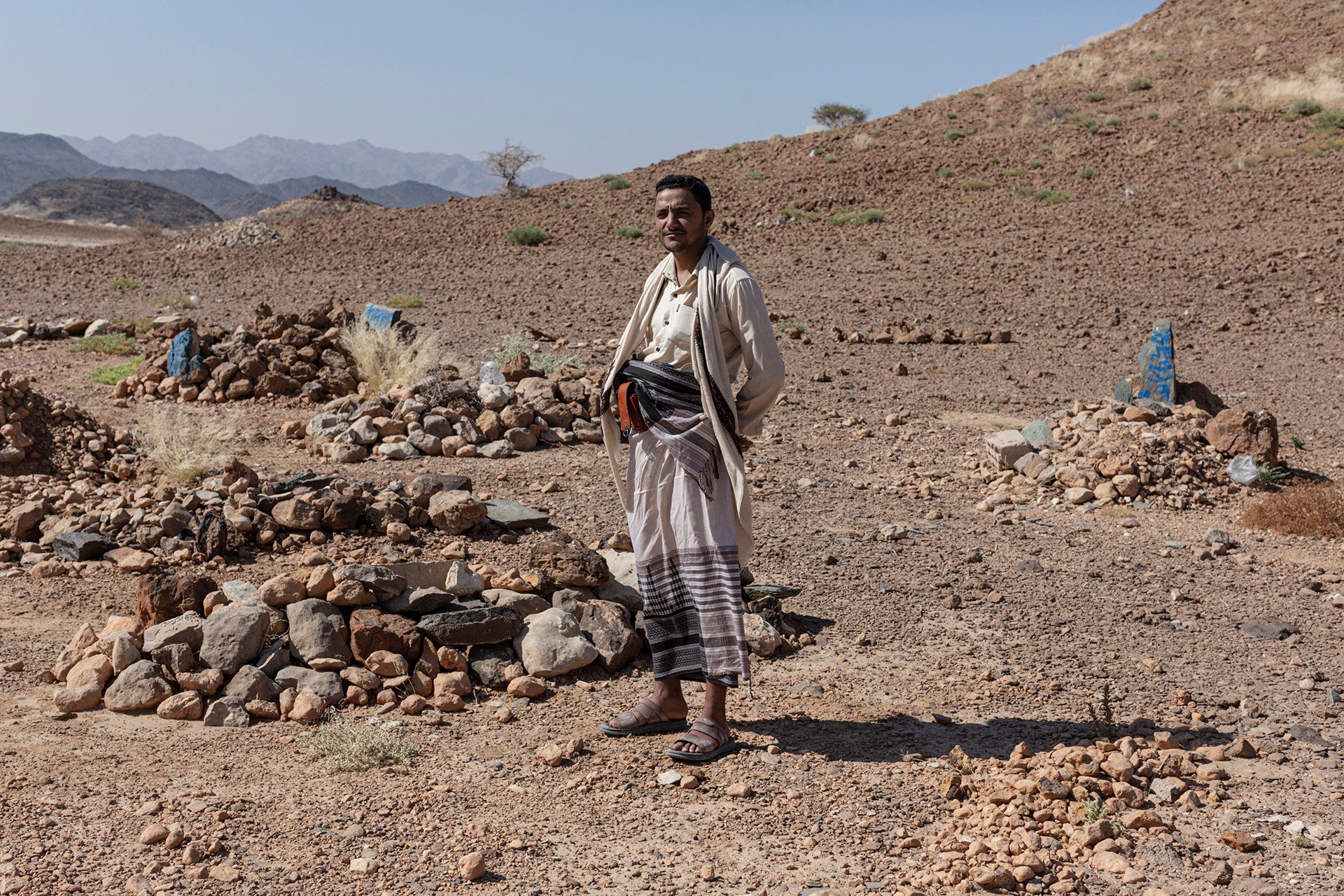
Human smuggler Ahmed Al-Awlaki stands at a site outside Ataq, Shabwa, where migrants are buried. November 16, 2020. (Sam Tarling / Sanaa Center for Strategic Studies)
He added that cities like Ataq, the governorate’s capital, suffer from increasing population pressure, that leads to friction between locals and migrants. He pointed out that this overcrowding affects the quality of life and also leads to “a rise in rental prices due to increased demand”.
In addition, Banafe’ stated that healthcare facilities are under significant strain due to receiving numerous migrant cases, including of dermatological, respiratory, or psychological conditions. The pressure on water and electricity services in densely populated areas also creates recurring crises.
Brigadier General Fouad Al-Nassi confirmed that the phenomenon has led to heightened security tensions and the spread of criminal behavior, as well as increased pressure on healthcare services and deteriorating social conditions.
On August 1, the district of Asilan witnessed an incident that sparked public outrage, when a local youth was stabbed with a piece of glass by four Ethiopian nationals. The attackers fled but were later apprehended by security forces.
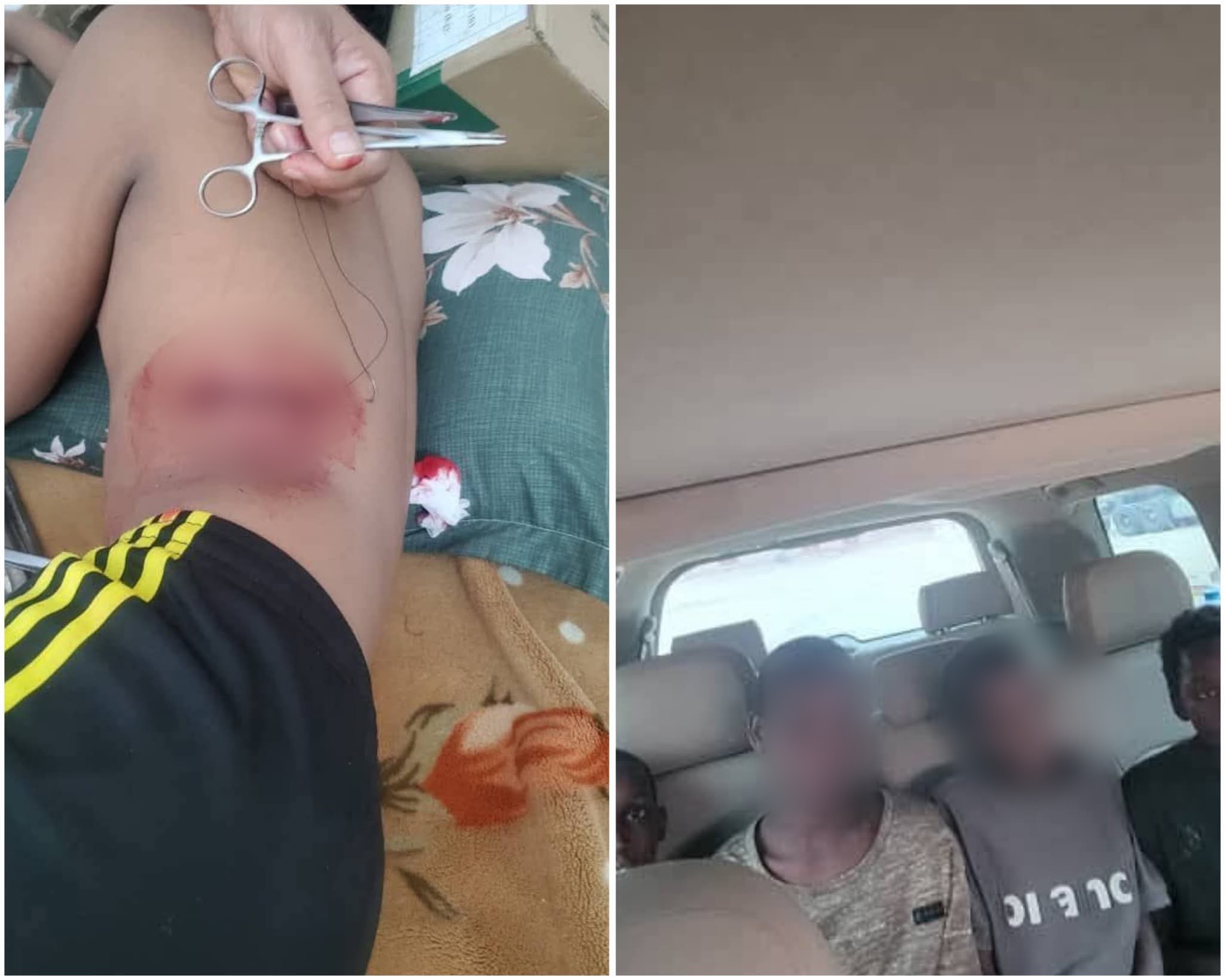
Shabwa – August 14, 2025: Local authorities arrest a group of Ethiopian migrants in Asilan after they stabbed a local citizen. The victim is receiving treatment for injuries. (Local media)
Proposed Solutions
Shabwa finds itself at the center of a transnational crisis, where humanitarian, security, social, and service-related dimensions converge. On one front, local authorities are engaged in rescuing victims and providing emergency aid to survivors; on another, they face mounting security and economic repercussions—all while operating with minimal resources and the near-total absence of dedicated international or regional support.
Journalist Farid Baras argues that “this dilemma cannot be fully eradicated under the current conditions, but its impact can be mitigated”, emphasizing on the need for a comprehensive package of security and development measures.
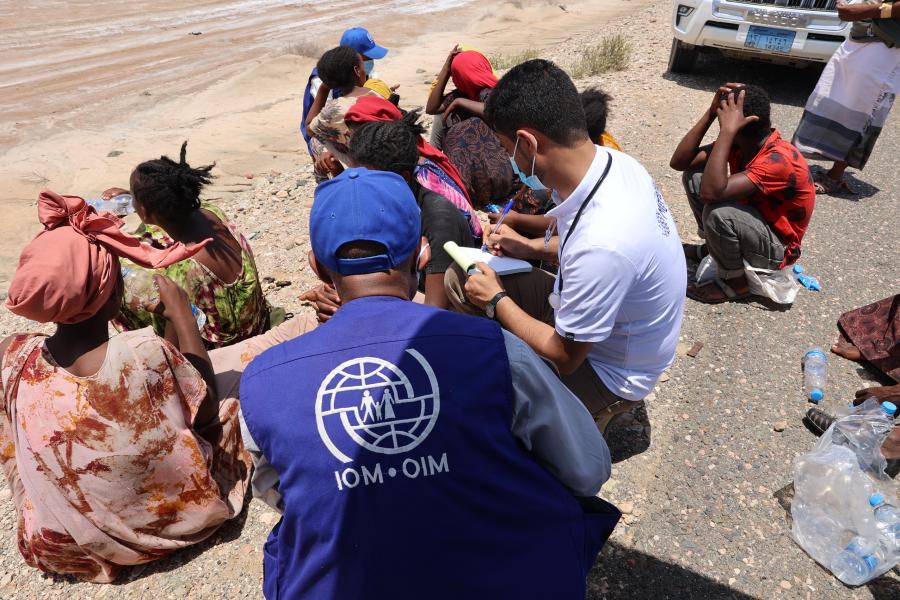
A special medical team from the International Organization for Migration (IOM) in Shabwah provides urgent assistance to migrants on migration routes (IOM/Majid Mohammed 2024).
The other participants echoed the urgent need for intervention, outlining a set of recommended actions:
• Enhancing security and surveillance capabilities by equipping Coast Guard units and border checkpoints with modern technologies and equipment
• Upgrading essential infrastructure to alleviate pressure on healthcare, water, and electricity services
• Implementing sustained community awareness campaigns on the risks of illegal migration
• Launching economic and development projects that offer alternative livelihoods and reduce the vulnerability of local populations to exploitation by smuggling networks
• Expanding the scope of international and regional cooperation to include financial aid, technical support, and specialized training programs
Amid the ongoing tragedies along the Eastern Migration Route, experts warn that failure to address the crisis could transform southern Yemen—particularly Shabwa—into a permanent hotspot for human trafficking, unless urgent and sustainable measures are adopted that integrate security and development, along with a human-centered approach.